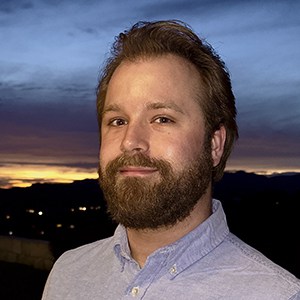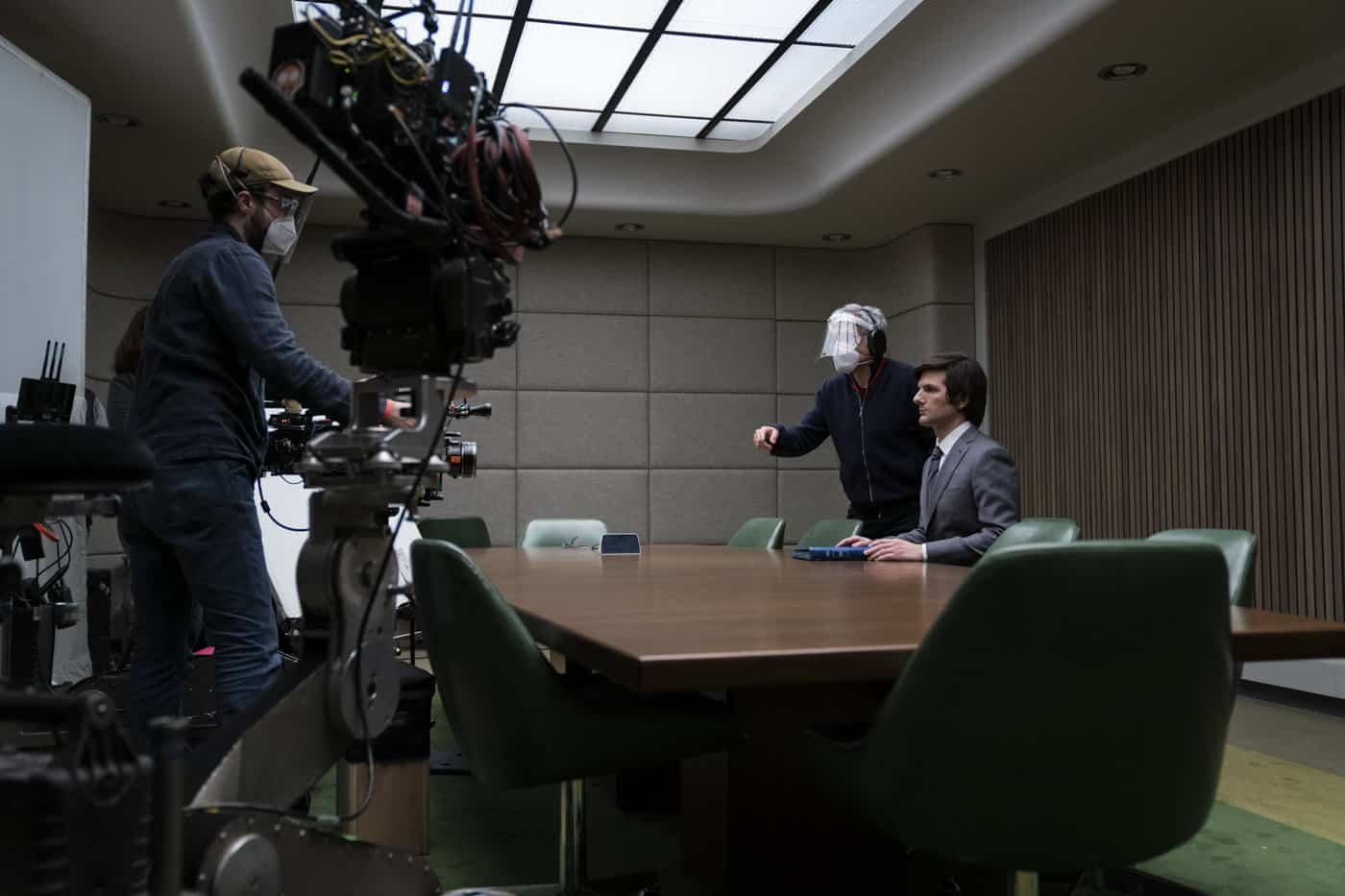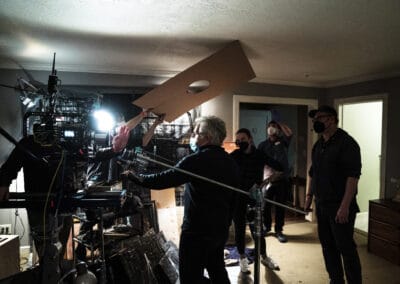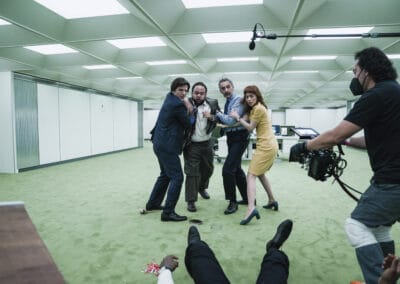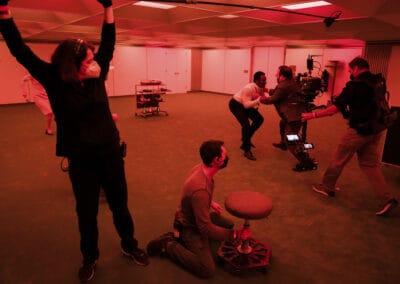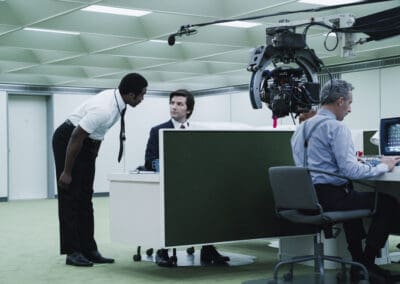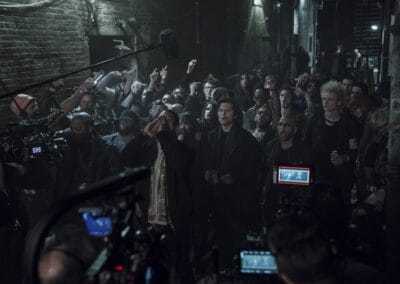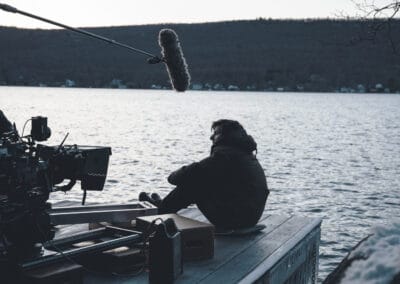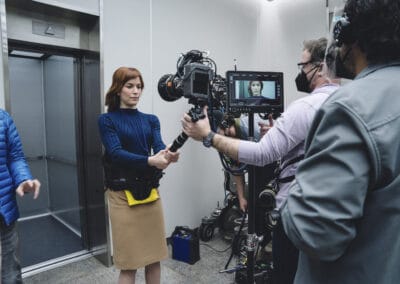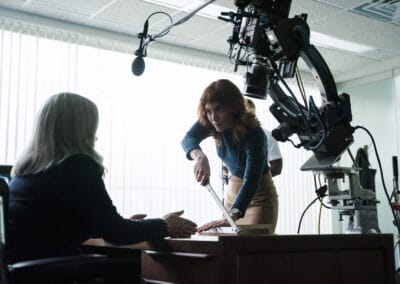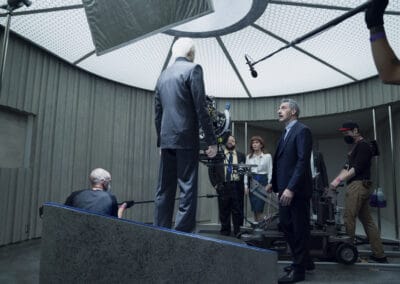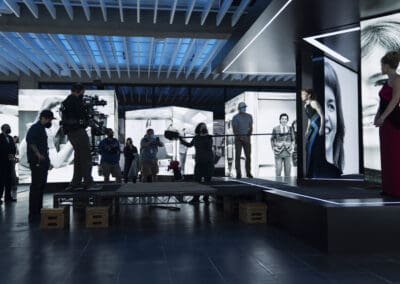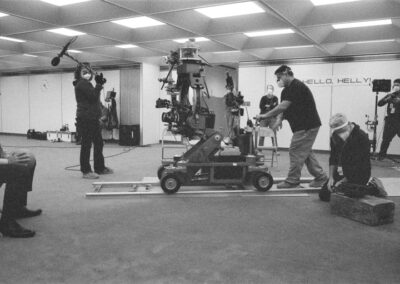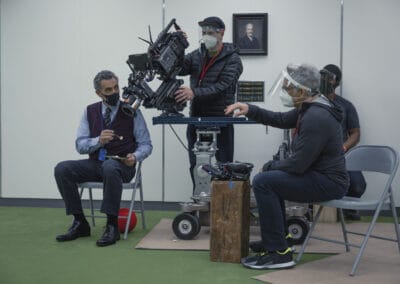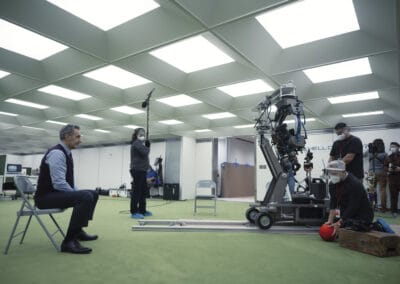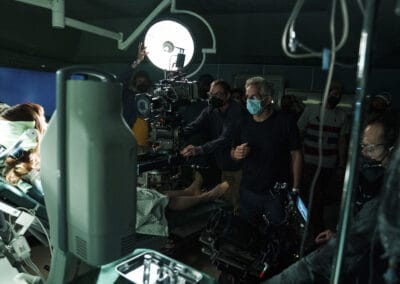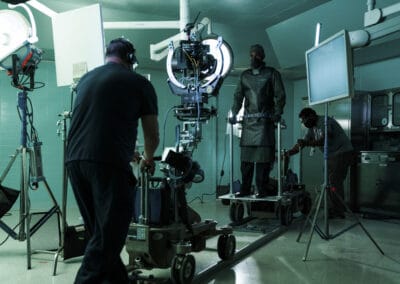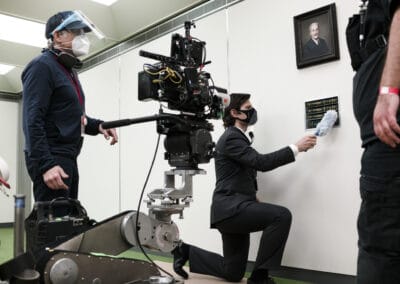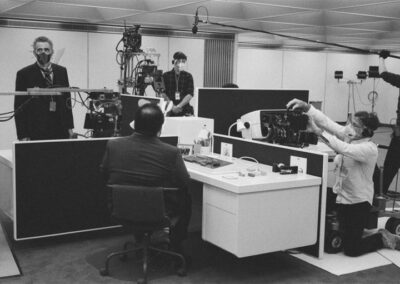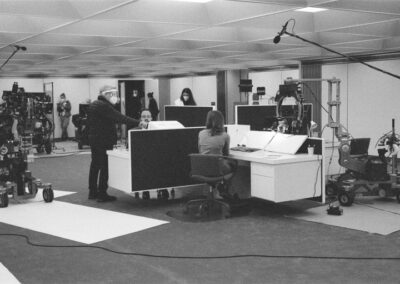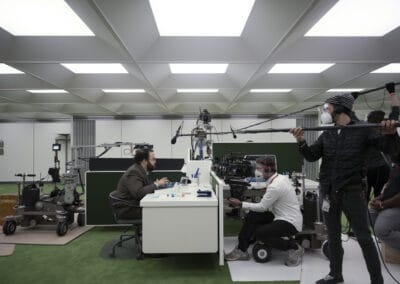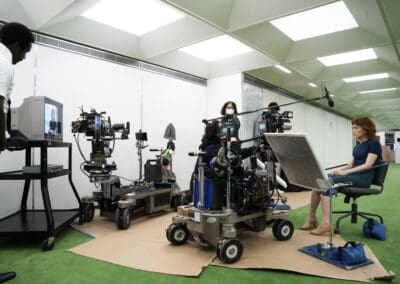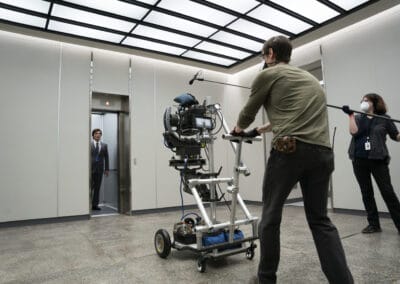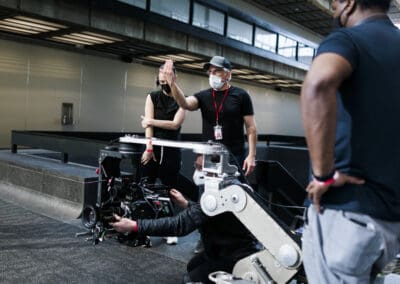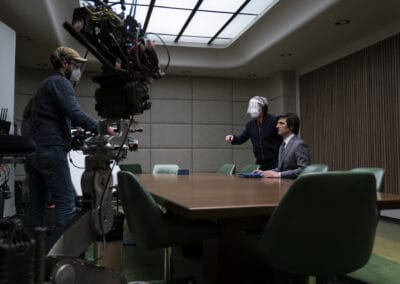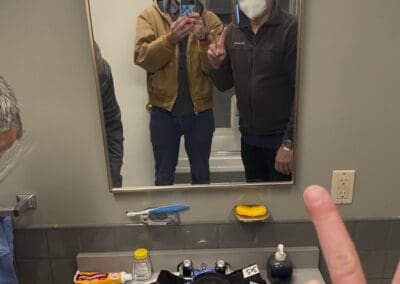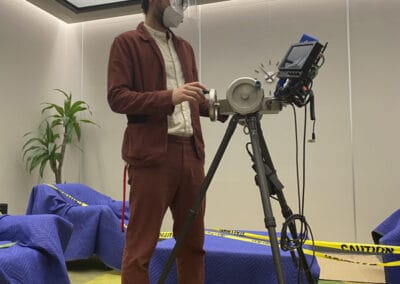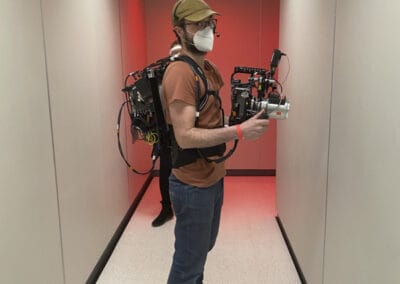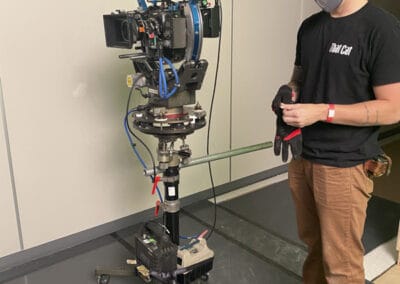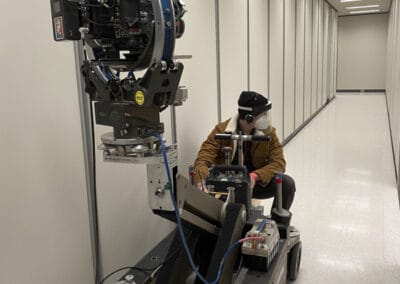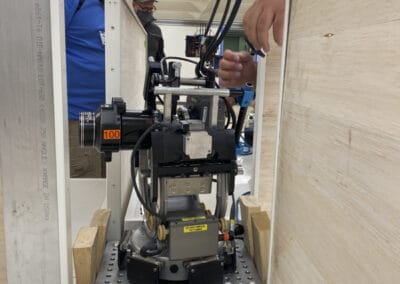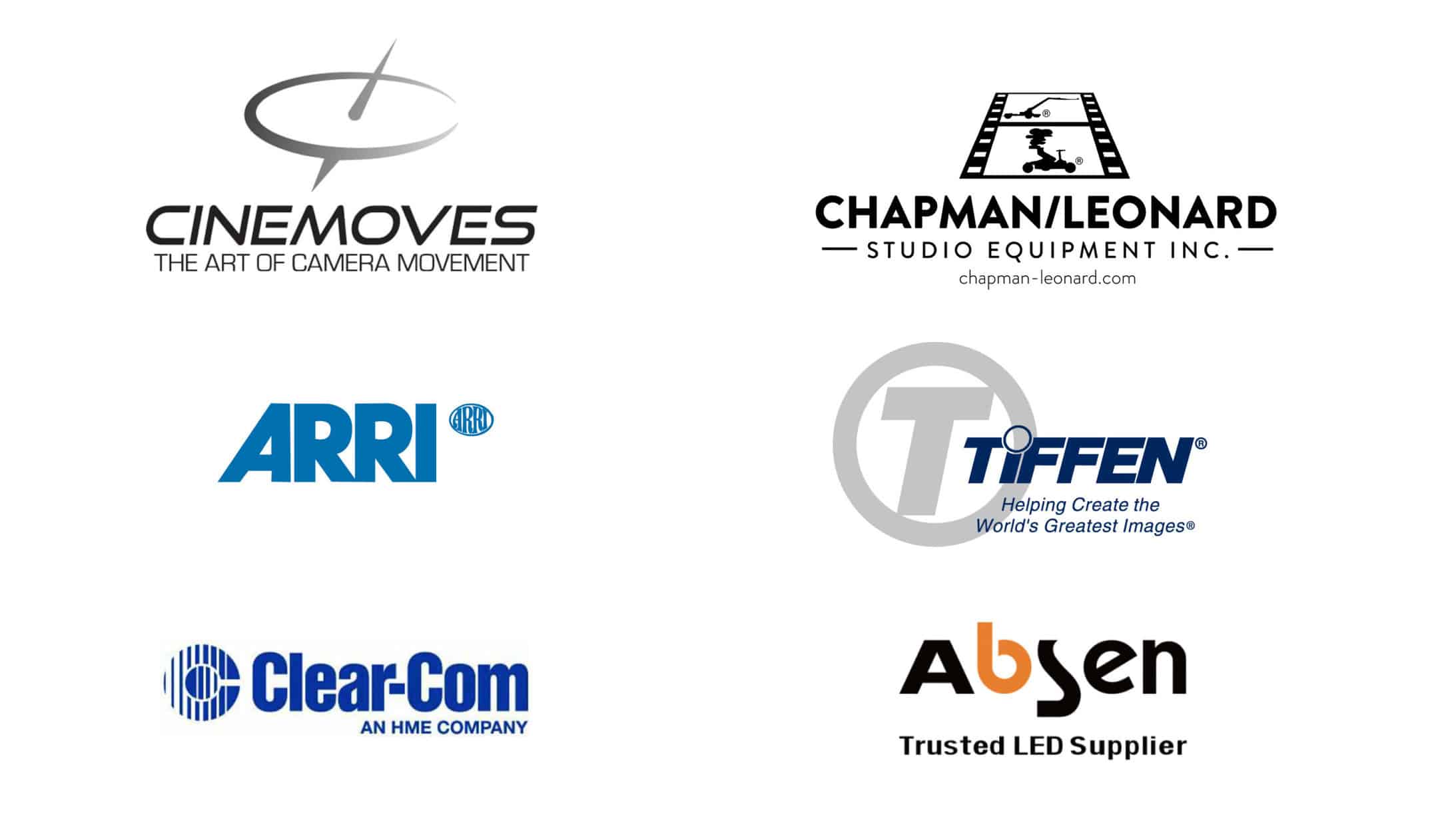Severance:
Research and Development
A Conversation with Sam Ellison, SOC
By David Daut
In the year since its release, Severance has gone on to garner critical acclaim and a host of accolades, including a nomination for SOC’s Camera Operator of the Year.
From whip-pans bridging different states of consciousness to creating a labyrinth of sprawling, seemingly infinite blank hallways, Camera Operator had the chance to discuss with “Blue” camera operator Sam Ellison, SOC, what it was like shooting on a show that’s meant to be deliberately disorienting and uncanny.
Taking the idea of a work/life balance to its logical extreme, Severance presents a world where a controversial new surgical procedure allows people to “sever” their consciousness, so that the version of you that goes home at 5 p.m. is unburdened by anything that happened during the work day. Meanwhile, the other half of your consciousness is trapped eternally at work with no nights, weekends, or hope of escape. The series is created by Dan Erickson and stars Adam Scott, Zach Cherry, Britt Lower, Trammel Tillman, Jen Tullock, Dichen Lachman, Michael Chernus, John Turturro, Christopher Walken, and Patricia Arquette.
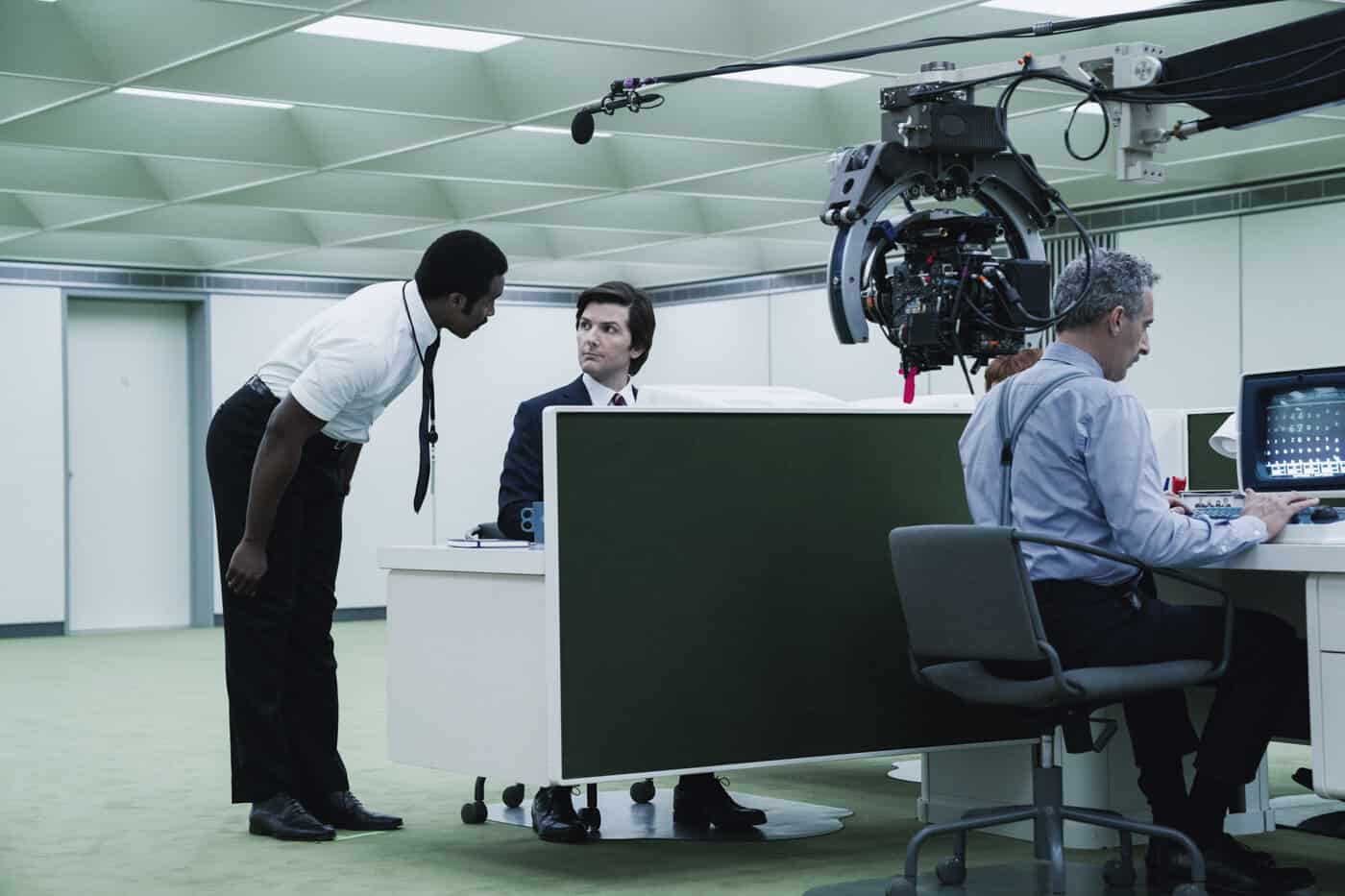
Tramell Tillman, Adam Scott, and John Turturro in SEVERANCE
Camera Operator: Severance has got to be one of the most interesting and exciting new concepts for a show I’ve seen in some time. How did you first get involved with the project?
Sam Ellison: It was one of those situations that I think a lot of us operators have encountered where it was almost a near-miss. Originally, I had been speaking with Jessica [Lee Gagné, director of photography], and actually met with Jessica and Ben [Stiller, director and executive producer] about the show back before the pandemic. They were originally planning to start shooting in the early months of 2020, and at the time my schedule ended up conflicting with another film. Then, all of us were suddenly plunged into COVID world. Severance ended up being one of the first projects that I was aware of in New York to get back on its feet. When they were trying to find operators and crew, I had a chance to jump back on the second time around. I think for all of us who were on the show, it became sort of the defining project during the hard months of COVID. When you’re working with all of the most stringent PPE protocols and all the other considerations, it makes doing the actual work on set pretty hard. So, it was a challenging show.
CO: Yeah, I’ve talked about that with a lot of other camera operators. That learning curve of getting adjusted to that reality of working in the PPE and the restrictions on how close you can be to the cast and one another, it was just such a such an interesting time.
Ellison: I had to deal with a face shield as well, which we ultimately abandoned pretty quickly. Trying to shoot all of that stuff with a sheet of plastic in our faces was very difficult. One thing that’s interesting about that is we were sort of mandated by the situation to shoot everything on a remote head all the time. Basically every single shot was on a Libra head—either the full size Libra or the Libra Mini from Monster Remotes. And so that rule ended up nicely blending into the style of the project, especially on the severed floor, where you want the camera to be especially robotic and sort of objective.
CO: Digging into that a little bit, there’s a lot of interesting stuff the show does to create this distinction between the severed floor and the “real” world. One of the signature bits of grammar you establish in the show is the dolly zoom on characters as they’re entering and exiting the severed floor. How did that come about, and what were some of the other tricks you use to highlight that difference?
Ellison: That was actually an interesting part of my job on this show. One of the most important aspects of doing this job is being as adaptable as possible and never approaching any two projects in the same way. It ended up being like that with Jessica and Ben, who had these very clear and precise ideas about exactly how the camera would move in the show, and they had immaculately storyboarded the whole thing months before we started shooting. I did have an interesting assignment near the beginning of the shoot when I ended up being sort of like the head research and development guy trying to figure out how to practically achieve some of these more difficult sequences that Jessica and Ben had conceived. So, I spent a lot of time over the first couple weeks of the show stepping away from set to try and figure out exactly how we wanted that dolly zoom to feel. Figure out which tools were the appropriate ones that would give them the sort of subtle effect that they were looking for. That’s how I think about that “innie” to “outie” transition shot; it’s just gentle enough that you might not notice it if you’re not paying attention, or especially for the lay audience, you can tell something’s happening to the image, there’s something changing about the person’s face, but I think it’s hard to put your finger on exactly what it is. It’s not as extreme as some of the quintessential dolly zooms, like Jaws or the Lord of the Rings zolly. Those are much more in-your-face and dramatic.
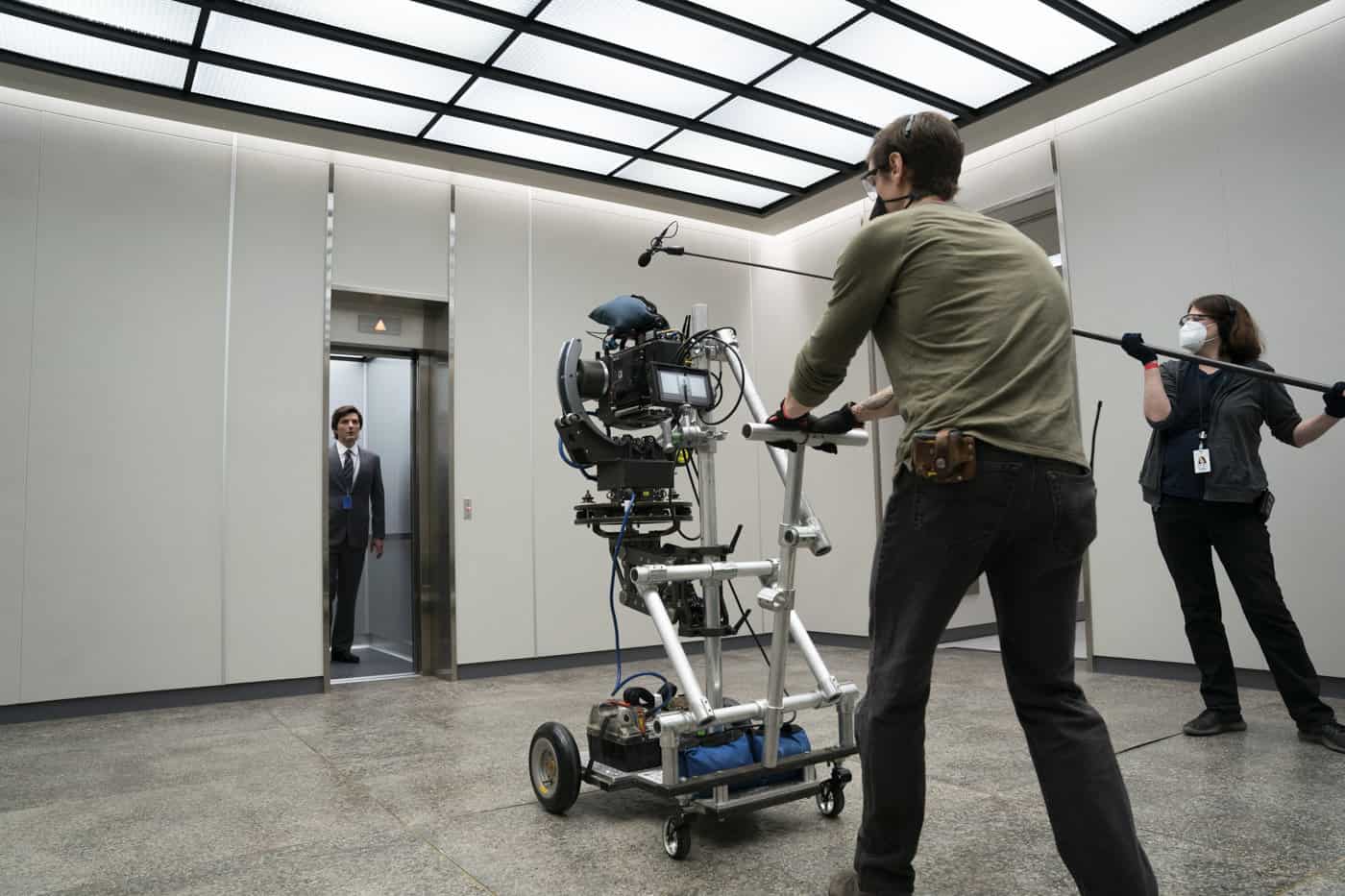
Dolly Grip Patrick Donahue with Adam Scott in SEVERANCE
We did end up using the Bolt Arm and a techno dolly for some of the more repetitive inside-the-elevator moves. We scheduled most of those on one day, and just did it over and over again with the different characters. But I think the more interesting part of it for me was, we came up with a way to do it just using simple motion control tools that would attach to our regular peewee dolly. We could set a dolly track and Patrick Donahue, my dolly grip, would be able to do his moves at whatever speed felt good, and the lens would automatically compensate. So, no matter where he was on his track, the zoom would adjust so that the character’s face occupied the same exact amount of the frame. That became especially useful in those sequences where Helly is trying to escape—where she’s going from the MDR hallway into the stairwell—but what we see is her just returning back into the same hallway. In those moments, we were able to do this dolly zoom motion control thing live and react to her in real time, however she was moving. It let us be more free with those movements than you would be if you had to program them into a big heavy piece of machinery like the Bolt Arm or a techno dolly.
CO: Speaking of that scene with Helly trying to escape, we see the two sides of that in two different episodes. In the one episode we see it from the severed Helly’s perspective as she pushes open the door and then is coming right back through the way she came in in a POV shot. Then you’ve got some similarly trippy stuff in Episode 3 with Petey as he’s hallucinating because of his reintegration sickness. I believe one of those was actually the clip they showed at the SOC Lifetime Achievement Awards a couple of months ago.
Ellison: Yeah! I chose that one for that reason, because I thought there was some pretty interesting stuff there.
CO: I imagine there’s a lot of VFX and editing tricks to stitch that together, but from a camera side of things, can you tell me a little bit about getting those shots?
Ellison: You know, a surprising amount of that stuff was done practically, using convenient pieces of architecture to wipe the frame. We did a lot of those with Helly in the stairwell and in the hallway; just the fact of the door being able to wipe gave us a really nice cutting point. There’s not a lot of actually taking one element and putting it into somewhere else, it’s just finding neat points to cut. I think that’s also true with that Petey sequence. That was actually one of the more fun and difficult ones for myself and [Green camera operator] Stanley Fernandez, because it was all this very fast, precise whip-panning back and forth that we would have to do. Each time we do the same movement on two different sets, because the gag is that he’s blinking back and forth between being on the severed floor in his office and being in the basement of Mark’s house where he’s hiding out afterwards. So, we would build these sets practically to match the spatial relationships between them. There’s one piece of dialogue between Mark and Petey that I’m thinking of; they’re sitting at their desks in MDR, and the spatial relationship between them is exactly the same as the relationship between them when they’re sitting on the couch in Mark’s basement. That allows us to run the dialogue, run the scene in both places and do these very precise whip-pans in both places. Then, by the magic of optics and editing, put it right together. So again, that sequence really doesn’t have very much fancy VFX in it. Practically, we did build the sort of desk divider that Petey uses to reveal the MDR office.
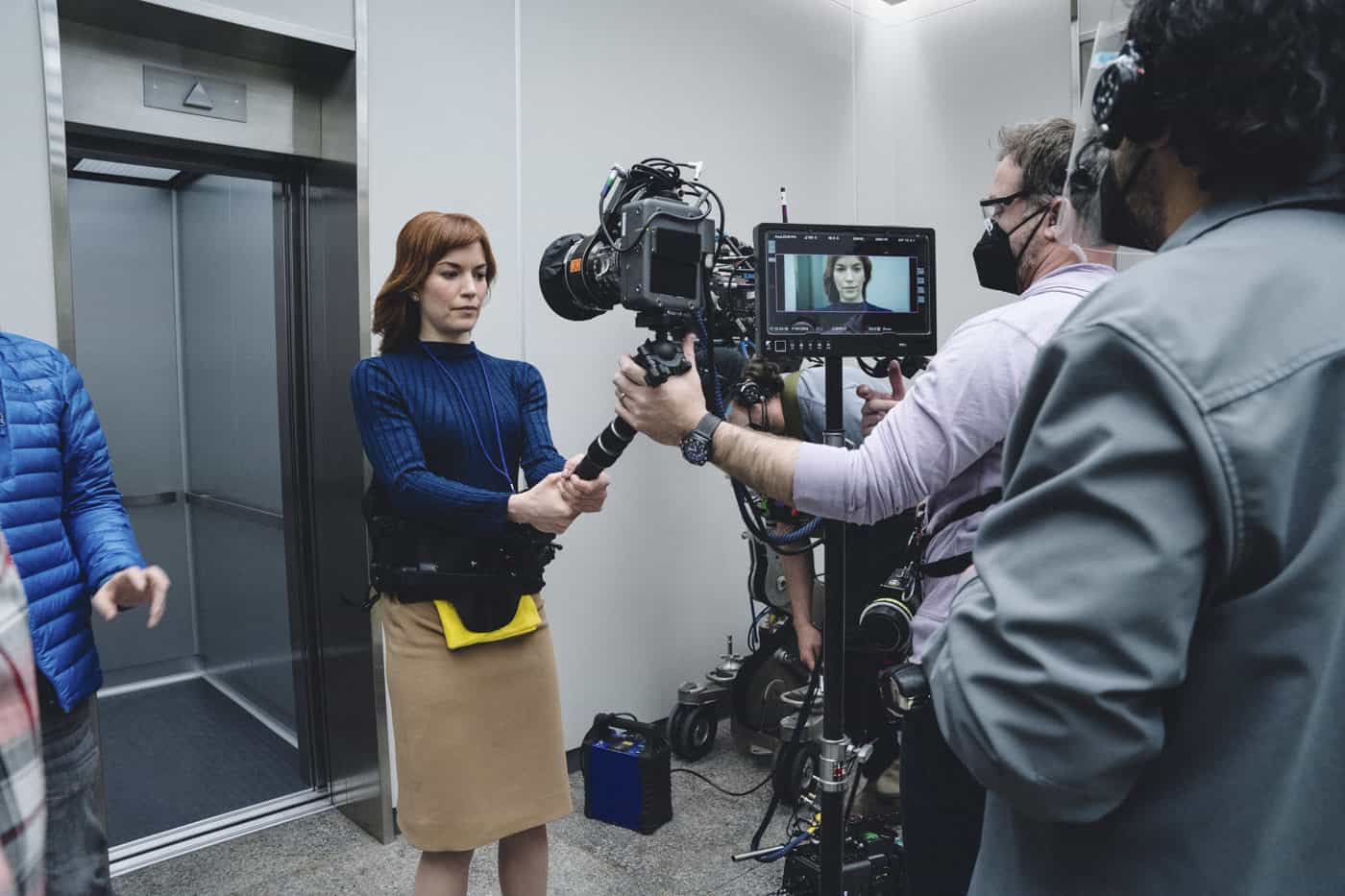
Camera operator Stanley Fernandez, SOC, and 1st AC Mike Guthrie (holding monopod) working with Britt Lower in SEVERANCE
That sequence was one of the ones that I would run off on my own and mock up and then show Jessica and Ben later to see if we’re getting close to the way they had envisioned these things happening. That was a big part of my role: to do tests—sometimes with the actors, sometimes with stand-ins—in the actual locations where you’re going to be doing these shots for real. Then I would do a little presentation for Jess and Ben and see what they thought. If they didn’t like it, we’d go back, modify it, try again, and show them version two. In that Petey sequence, there’s a Steadicam shot that brings him out of the basement bathroom into MDR, and that was all practical. There’s not a single bit of cutting or stitching in there at all. It was just a matter of putting the lens in the right place so that in the mirror you can see the basement set, and then as soon as Turturro wipes the frame, we pan around and see the MDR set as it is. So, that’s another example of something that we had to very carefully design ahead of time and build a set that would allow this to work. But then the actual execution of it was all practical and we just did it live with no fancy stuff.
CO: Beyond the stuff with Petey’s hallucinations, are there any other moments that spring to mind where you had this idea, you developed it, and you brought it to Jessica and Ben and they loved it? Or on the flip side of that, was there anything where you had this idea and then, for whatever reason, it just wasn’t going to work?
Ellison: The most difficult one to execute ended up being something that doesn’t quite exist in full in the final cut, but it was a shot of Helly as she has the severance procedure done to her. It begins in an extreme close-up on her eyeball as she’s lying on the operating table, and then sort of seamlessly wraps around and resolves into a shot of Helly in motion, walking down the corridor on the severed floor. The real challenge of that one was finding a lens that could be close enough, because we wanted to do it without cutting, without stitching, without a VFX solution. And then it was a question of whether we needed Britt Lower to be on her own dolly while the camera was on a different dolly in order to do this very precise pull out from her extreme close up. I mangled that several times in testing to the point where everyone started to be confused about exactly what we were trying to achieve. I think sometimes in these situations, you can end up overcomplicating things by trying to do too much. If I remember correctly, we ended up simplifying it; we didn’t do any fancy stuff with two dollies, we just put the camera on a slider and had Helly riding on a dolly seat with the camera slider. I rode on the dolly with them and manually did a two-foot move, and that ended up being all that was necessary. I think that was the most difficult example of a shot where it took us several iterations to even understand what it was that we were trying to do, but it was fun. Every job is different, and the challenges are different, and the hardest part of this one for me was that stuff. Designing these shots because Jessica and Ben were busy doing 10 million other things, and they needed somebody to help work this stuff out for them. That felt like my most important role, at least early on.
CO: Thinking about the look of the show, on the severed floor, it’s this labyrinth of endless, similar hallways. Obviously given the realities of real-world space, you can only make the set so big, so I assume there was a lot of reusing pieces of sets for different areas of the severed floor. How did you approach shooting those same sets to make them feel like different parts of this huge, endless space?
Ellison: I hope I’m not giving away any company secrets or anything, but the real answer about those corridors is they were just built around the entire perimeter of the stage, and the art department was able to pretty quickly change the layout. They could add some corners for us or add a door, take away a door, cover up the entrance to where MDR would normally be, so we just get a much longer run of white corridor. We occupied all of York studios in the Bronx, so we had several stages at our disposal, and we had a whole lot of that white hallway in various forms. I think the sort of ever-changing nature of the set also gave us on the crew a sense of being on the “innie” side of things. When you leave work, things are one way, then you come back and it’s like no time has gone by, but the whole world has changed.
The other thing about the “innie” versus “outie” world is the lenses. We were anamorphic the whole time, mostly on these G-Series Panavision lenses, but the main difference was, on the severed floor, we tried to be on wider lenses whenever possible. So, we went from the wide angle inside Lumen, and then we go more telephoto, and a little bit more organic feeling when we’re in the regular world outside.
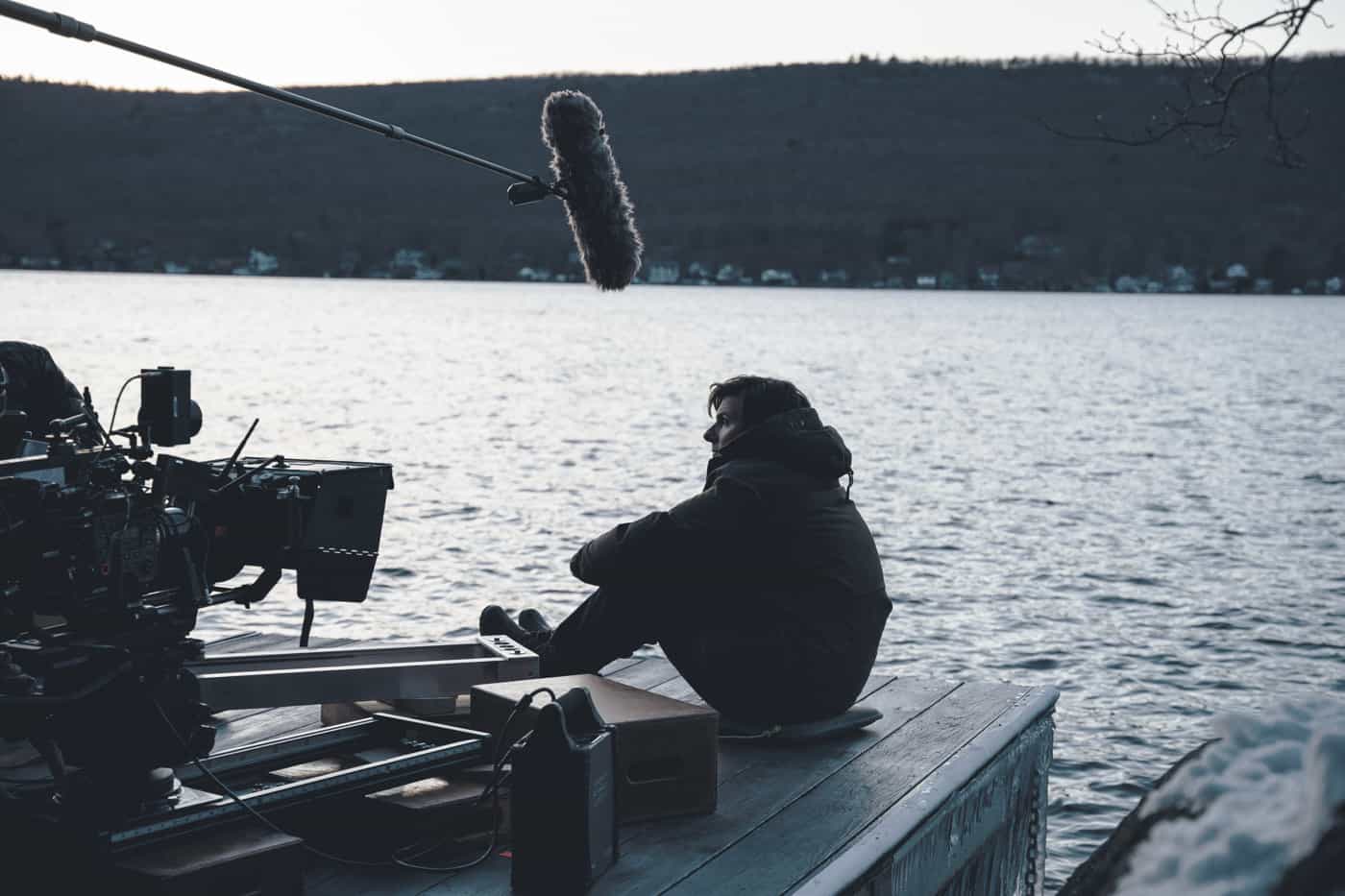
Adam Scott in SEVERANCE
CO: As I was rewatching it, I could sort of tell there was a difference, but I couldn’t quite put my finger on what it was. That makes sense.
Ellison: With all of these rules, they only apply 80 or 90 percent of the time. There’s always exceptions. But in general, we defaulted to the wider lenses for close-ups in MDR.
CO: Speaking more broadly about the show, what were some of your most memorable experiences working on it? Any specific moment with the cast? You’ve talked a little bit about trying to solve these puzzles of particular shots, but I wonder if there’s anything else that comes to mind in that regard.
Ellison: I think being the intermediary between the cast, the director, and the director of photography is an unsung part of the job of a camera operator. Getting to hang out in the presence of Christopher Walken and John Turturro when they have their romantic interlude was really awesome. All of cast in Severance is incredible, and all those actors are so much fun to be around, but there was something pretty cool about that Walken/Turturro stuff. It was particularly memorable for me because, when you’re covered in PPE, it’s hard to even see who you’re talking to, but they’re amazing. Sometimes as an operator, you have the best seat in the house and it’s just fun to watch the cast do their thing.
I also have one funny story. There’s sort of a high-speed chase moment as Helly is trying to break out, I think for the second time. Mark is running down the hall to stop her as she’s smashing the staircase door with a fire extinguisher to try to write a note to herself on the outside. I was doing a full speed, reverse handheld running shot with Mark, and I ended up slamming into the back wall hard enough that I created an indent, like a cut out version of myself in the set.
CO: [Laughs] So, a little bit Looney Tunes.
Ellison: [Laughs] Exactly, a little Looney Tunes. Yeah, it got wild.
CO: There might not be a bigger answer to this, but I was noticing that you’re credited as “Blue camera operator,”and then there’s “Green camera” as well. Is that a term I’m just not familiar with? I know there’s kind of like a blue and green motif running throughout the show. Is it just playing off of that?
Ellison: No, it just started out as an attempt at being non-hierarchical. That’s the real answer. I think they also did this on Escape at Dannemora, which was the previous project that Ben and Jessica worked on together. It’s just a style thing. I believe it comes from Ben himself. It was a way to avoid having A camera, B camera, all that. Because, you know, we had some really amazing operators on the show, and I think it was important to our leaders that we feel like a more of an egalitarian team, and less like a hierarchy.
I can’t say enough about how amazing and how clear-headed Jessica and Ben were on this project. They had a very specific vision that was there on the wall of Jessica’s office before we shot a single frame, and they did not deviate from that one bit. To me, that’s the kind of work that I like to do. I’ll do anything, but I’m not so into that “just go find something” style. I like to really work within a specific style, a specific framework, and try to make that shine. Ben and Jessica are incredibly incredible, then Eric Swanek, my first AC, was sort of a New York City legend. He was able to pull off stuff that was almost impossible focus wise, and he did it with a smile and never got frazzled. It was a pretty stressful set to be on in a lot of ways, but Eric handled it like the ultimate professional that he is. I also want to give another shout out to Pat Donahue because, given that we were on remote heads the whole time, he did a lot of heavy lifting. Especially in those hallway sequences, I was on the other side of the stage with my little Libra head controls while Patrick was the one who was driving around with the actors. He was a very important part of the mix. Plus key grip Johnny Erbes-Chan, Mike Guthrie, my fellow operators– I could go on.
CO: Well, I’ve got to say, it’s a really incredible show. I fell in love with it when I watched it about a year ago, and after revisiting it for this interview, I think it’s maybe the best first season of a new show since—I don’t know—Lost, maybe. It’s been a while since there has been something this exciting right out the gate. And that season finale episode—
Ellison: Yeah, it’s crazy! All of us are shut down currently because of the strike, but they’re in the middle of shooting Season 2. I’m not working on the second season of Severance, but I cannot wait to see what they do with it. A lot of that crew are close friends of mine at this point, so I check in with them and try to get some hints, but it should be a lot of fun.
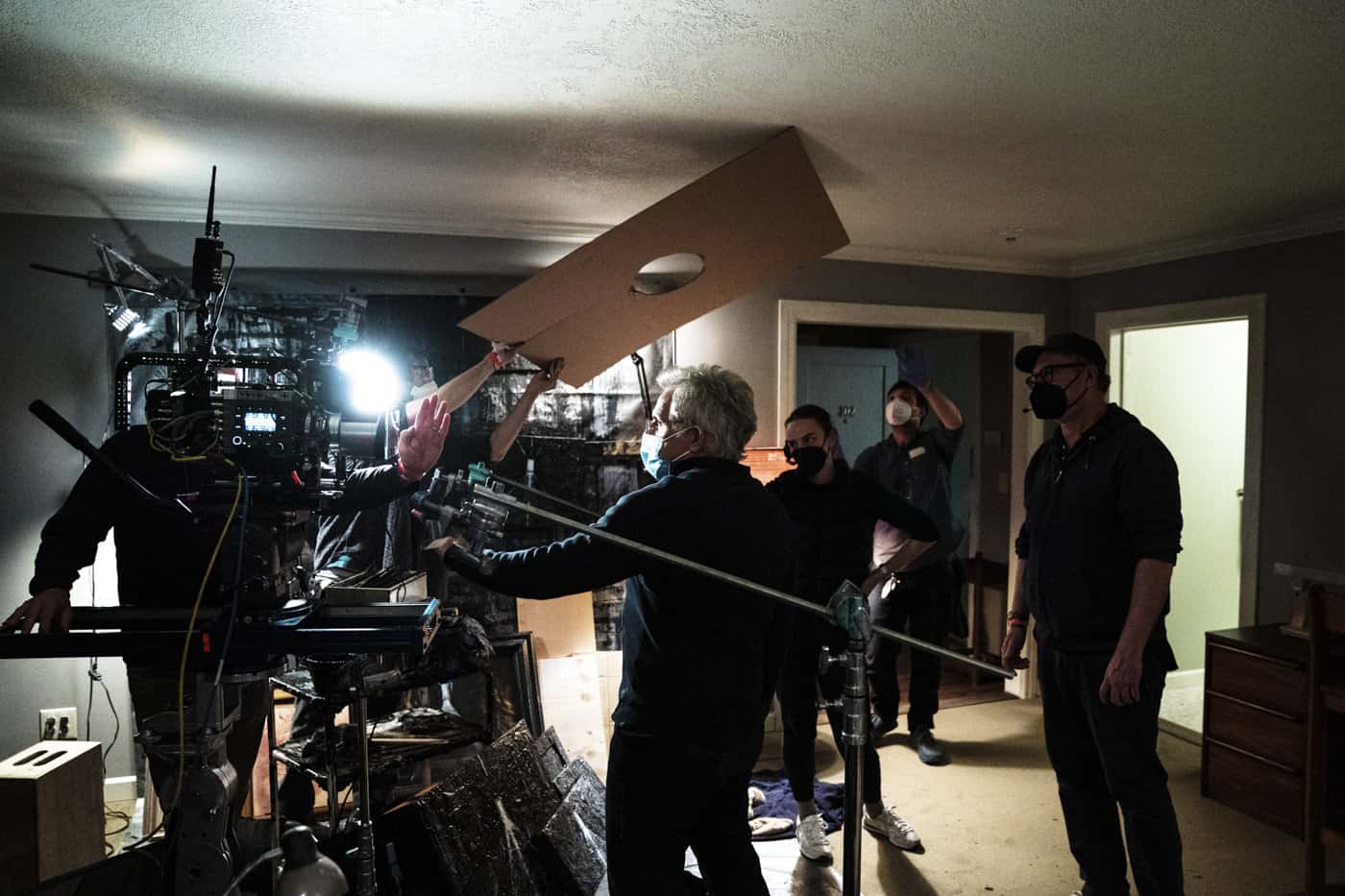
Shooting SEVERANCE
Camera Operator Summer 2023
Above Photo: Camera operator Sam Ellison, SOC, with director Ben Stiller and Adam Scott on the set of SEVERANCE
Photos courtesy of Apple
TECH ON SET
Sony Venice with Rialto Mode (3 cameras most days)
Panavision G Series Anamorphic Prime Lenses
Libra Head & Libra Mini
Chapman PeeWee & Hybrid Dollies, Custom Narrow-base Rickshaw
BEHIND THE SCENES
Select Photo for Slideshow
Sam Ellison, SOC
Sam Ellison, SOC, is a camera operator, traveler, and documentarian based in New York City. Specifically, he lives in Ridgewood Queens, which was recently named the 4th-coolest neighborhood in the world. Sam has been nominated for SOC’s Camera Operator of the Year for his work on A Beautiful Day in the Neighborhood and Severance. Other highlights of his recent operating work include The Penguin (in production), The Nickel Boys (2023), The Good Nurse (2022), I Know This Much is True (2020), and the Academy Award–winner Manchester By The Sea (2016). Sam also directed a feature documentary, Chèche Lavi (Looking for Life), which premiered at Rotterdam in 2019 and played a long run of festivals worldwide. He received his BA from Harvard and his MFA from Stanford University.
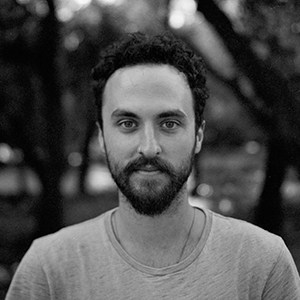
David Daut
A writer and critic for more than a decade, David Daut specializes in analysis of genre cinema and immersive media. In addition to his work for Camera Operator and other publications, David is also the co-creator of Hollow Medium, a “recovered audio” ghost story podcast. David studied at the USC School of Cinematic Arts and works as a freelance writer based out of Orange County, California.
